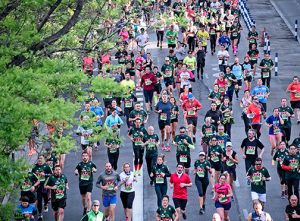 If you’ve never run competitively before and want to plan and prepare for a marathon (26.2 miles) or half-marathon (13.1 miles), you need to start a training plan and stick with it at least six up to fifteen weeks before you expect to compete. Start by entering shorter competitions like the 5K (3.1 miles) or 10K (6.2 miles). Entering shorter races makes you more aware of your skills and how competition can alter the way you run when you’re running solo.
If you’ve never run competitively before and want to plan and prepare for a marathon (26.2 miles) or half-marathon (13.1 miles), you need to start a training plan and stick with it at least six up to fifteen weeks before you expect to compete. Start by entering shorter competitions like the 5K (3.1 miles) or 10K (6.2 miles). Entering shorter races makes you more aware of your skills and how competition can alter the way you run when you’re running solo.
Take your training seriously.
You need a minimum of eight to ten miles of running each week for two months before you start marathon training. During training, you won’t run every day. Your body needs rest days and other types of exercise, or you’ll be prone to overuse injuries. Many runners use two non-consecutive days for rest or mild exercise like swimming. Two non-consecutive days are often devoted to running a shorter distance at a moderate pace, faster than you’d use for a marathon or half-marathon. Two non-consecutive days are for cross-training to build strength and muscle endurance. One day is for the marathon or half-marathon distance you do at a leisurely pace or walk/run training.
Make sure you have the best footwear.
You don’t have to have the latest running suit or look like an Olympic champion when you run. You do need the best shoes that you can afford. Footwear is the most vital part of your running gear. If you have a specialty shop near you that sells footwear for runners, seek their advice. A good fit is more important than finding the best shoes for distance running. Sweat-wicking socks are also a must.
Cross training should complement running and make you better.
Not all cross-training is as beneficial for runners as others are. Each brings something to the table. Cross-training should reduce the risk of injury, build strength, improve muscular and cardio endurance, and provide a mental break. Working with weights may build muscular endurance but won’t benefit mobility like yoga and stretching. Choosing the type of cross-training helps you overcome your weaknesses. Cross-training also provides fitness in all areas, not just endurance, and corrects imbalances caused by running.
- Buy a second pair of running shoes when you find the perfect ones. Train in them for about 50 miles and save them for the race day.
- Some people use one day of running to do speed training. It may be interval training, Fartlek training, or tempo running. Fartlek training is often the easiest. You alternate your speed throughout the run, hitting peak speeds periodically.
- Don’t try to conquer the entire distance at peak speed. Learn to pace yourself to develop your stride and running form. You can’t cram for this test. You have to build gradually.
- Eat a balanced diet. Choose the foods you’ll eat the day before the race and the day of the race by consuming them during practice days to ensure they agree with your body. Don’t try new energy bars or products on race day.
For more information, contact us today at VIP Fitness Center
